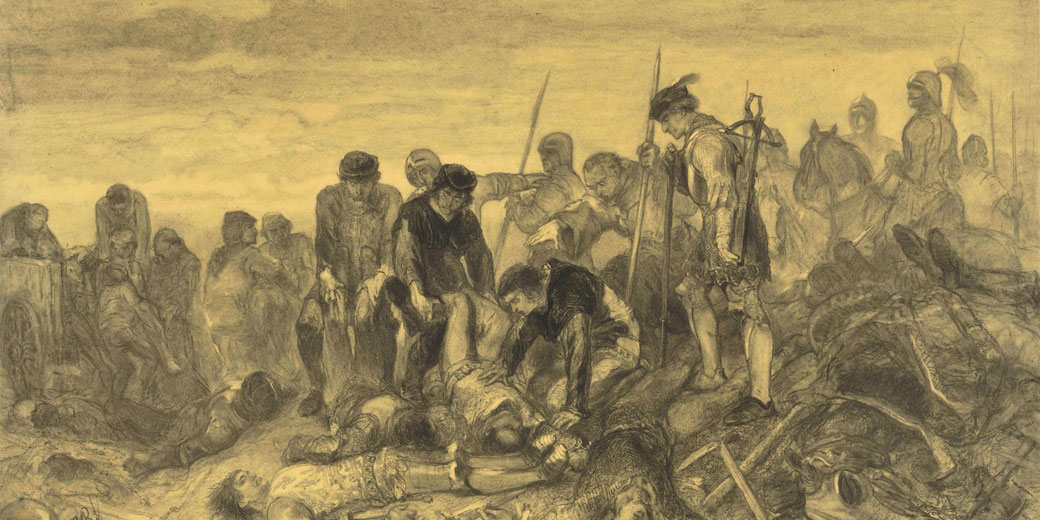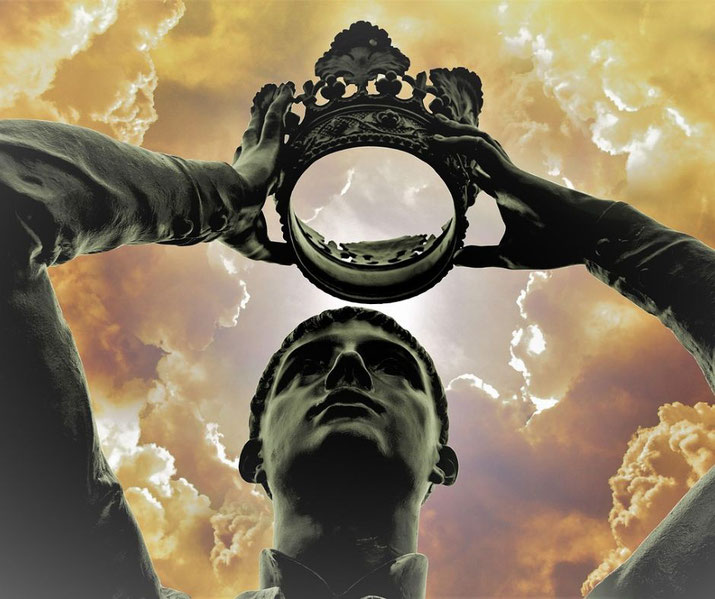How the Battle of Bosworth changed England forever

A king’s crown rolled in the dirt as soldiers cheered a rival’s unexpected victory. This engagement of great importance brought about the end of the Wars of the Roses and the fall of the Plantagenet dynasty.
Historians still argue whether betrayal or bad strategy decided the king’s fate. However, to understand the full importance of this battle, we must look at how its outcome influenced the course of the English monarchy.
Wars of the Roses: The civil war tearing England apart
The Wars of the Roses, a series of conflicts lasting from 1455 to 1485, preceded the Battle of Bosworth.
These wars resulted from long-lasting tensions within the English nobility, mainly between the rival Houses of Lancaster and York.
Both sides claimed descent from the Plantagenet line and thus had valid claims to the throne.
Weak leadership, money troubles, and divisions among themselves made the conflict worse, creating a dangerous mix that affected England for over three decades.
Because of these issues, power shifted frequently during this period as the throne changed hands between Lancastrian and Yorkist rulers, and each reign had its own successes and failures.
In this time of changing loyalties and ongoing fighting, Richard III became king in 1483 under questionable circumstances.
His late brother Edward IV’s two young sons were declared illegitimate and later disappeared, leading many to suspect Richard of their murder.
Richard III’s rule was plagued by rebellions and controversy over his reputation, and Henry Tudor, little-known and with a weak claim to the throne through his mother’s Lancastrian family line, plotted to unseat Richard.
Henry Tudor’s landing in Wales in 1485 was a gamble, but it paid off as he marched through the country and gathered support.
Aware of the threat Henry posed, the Yorkist king also began to gather his forces, which included experienced fighters from the Wars of the Roses.
Richard was confident, perhaps overly so, because he believed that his larger army and experienced troops would ensure victory.
The two different armies
Richard's forces comprised a formidable assembly of seasoned veterans, and knights and nobles loyal to the Yorkist cause, numbering around 10,000 to 15,000 men according to various historical estimates.
Richard had a range of military resources at his disposal, including cavalry, infantry armed with longbows and bills, and even some artillery.
Because the Yorkist army was both larger and more experienced, Richard surveyed the battlefield from his vantage point on Ambion Hill with considerable confidence.
Across the field, Henry Tudor's army was significantly smaller, numbering between 5,000 and 8,000 men.
Although his force lacked in size and experience, it compensated with determination and the element of surprise.
Henry's troops formed a diverse array: exiled Lancastrian loyalists, French mercenaries provided by his foreign backers, and English rebels joined during his march from Wales.
The army also included a contingent of Welsh soldiers, drawn to Henry partly because of his Welsh ancestry through his father Edmund Tudor.
Despite the troops' disparate origins, Henry managed to forge a sense of unity aided by the tactical acumen of experienced commanders like 13th Earl of Oxford John de Vere.
A third force was also present at this battle. An army of around 4,000-6,000 commanded by Stanley brothers Thomas and William, who were powerful nobles. Initially they were strategically positioned observers from a distance, with speculation surrounding their ultimate allegiance.
Richard III had taken Lord Stanley's son as a hostage to secure the family's loyalty. However, the Stanleys were also related to Henry Tudor through marriage, as Thomas Stanley had wed Henry's mother Margaret Beaufort.
Such a familial connection cast a shadow of uncertainty over their loyalty, making them a crucial factor that could tip the scales in favor of either contender.

How the battle unfolded
When the morning mist that had shrouded Bosworth Field lifted, two armies stood poised for a battle that would reshape England's destiny.
Richard III atop Ambion Hill gave the order and his Yorkist troops advanced.
Across the field, Henry Tudor, who was flanked by his commanders, watched as the Earl of Oxford led the Lancastrian forces forward.
The initial skirmishes proved fierce and inconclusive because both sides sought to gauge their opponents' strength and tactics.
Arrows flew, artillery roared, and the clamor of steel on steel filled the air.
As the battle raged, Richard III perceived an opportunity to bring a swift and decisive victory. He spotted Henry Tudor relatively unprotected, making a bold decision: he would lead a cavalry charge aimed at killing Henry and ending the battle in a single stroke.
With a cry, Richard led his knights in a thunderous charge across the field and they cut down anyone who stood in their way.
William Brandon, Henry’s standard-bearer, was killed during the cavalry charge, underscoring how close the Yorkist king came to reaching his rival.
But just as victory seemed within reach, the unexpected occurred.
The conspicuously neutral Stanley forces sprang into action and, led by Sir William Stanley, joined the fray on Henry Tudor's side, turning the tide of the battle in a moment that would become the stuff of legend.
The intervention of the Stanley forces delivered a devastating blow to Richard III, who, though he was outnumbered and surrounded, continued to fight and refused to retreat.
His cries of "Treason! Treason!" echoed across the battlefield, a poignant testament to the betrayal he felt, and in the end Richard III was cut down and his body, left on the field, a grim marker of the end of the Yorkist reign.
"The king is dead," the cry went up, and with it, the battle's fate was sealed.
The aftermath and its consequences
Henry Tudor, now the undisputed winner, was quickly crowned on the battlefield with Richard’s crown, which had been found in a thorn bush.
The dust had barely settled on Bosworth Field when the meaning of what had happened began to sink in.
Richard III, the last Plantagenet king, lay dead; his reign had been brought to a sudden and violent end.
Henry VII wasted no time in making his rule official and dated his reign from the day before the Battle of Bosworth, marking all who had fought for Richard as traitors.
This allowed him to take their lands and money, increasing his own wealth.
But Henry also knew that his rule needed to bring people together and heal a nation tired of decades of civil war, not just punish the defeated.
To help this cause, he married Elizabeth of York, daughter of Edward IV and sister to the missing Princes in the Tower.
This marriage brought together the fighting houses of Lancaster and York, and the Tudor Rose, a combination of the white rose of York and the red rose of Lancaster, became a powerful sign of this new unity.
The coronation of Henry VII was a carefully planned ceremony, designed to show stability and that God approved.
As he was crowned in Westminster Abbey, the message was clear: the Wars of the Roses had come to an end, and a new era had begun.
Henry set about establishing a strong central monarchy.
His reign would see not only the end of an internal war but also the beginning of England’s rise as an important power on the European stage.
Why was this battle so important?
The end of the Wars of the Roses and the rise of the Tudor dynasty marked a turning point in English history, starting a time of important changes that would have long-lasting effects.
Henry VII’s rule laid the foundation for a stronger central government, introducing financial and legal reforms that strengthened the monarchy and reduced the power of the nobles.
These changes helped stabilise a country that had been torn apart by civil war, setting the stage for a period of peace and wealth.
The Tudor dynasty itself would become one of the most famous in English history, producing figures like Henry VIII and Elizabeth I, who left significant marks on the country’s religion, politics, and culture.
The establishment of the Church of England under Henry VIII and then Elizabeth I’s contributions to literature, exploration, and the arts can all trace their roots back to the pivotal moment when Henry Tudor defeated Richard III on Bosworth Field.
The battle also had a deep effect on how people viewed the English monarchy, shifting it from a prize to be won in battle to an institution with God’s approval and legal authority.
This change in view helped to lay the foundations for the constitutional monarchy that would later emerge, forming the political structure of modern-day Britain.
What do you need help with?
Download ready-to-use digital learning resources
Copyright © History Skills 2014-2025.
Contact via email
With the exception of links to external sites, some historical sources and extracts from specific publications, all content on this website is copyrighted by History Skills. This content may not be copied, republished or redistributed without written permission from the website creator. Please use the Contact page to obtain relevant permission.





